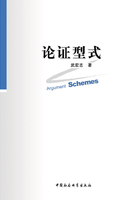
参考文献:
[1] Douglas N.Walton,“Justification of Argument Schemes”,Australasian Journal of Logic,Vol.3(2005),pp.1-13.
[2] J.Anthony Blair, Groundwork in the Theory of Argumentation:Selected Papers of J.Anthony Blair,p.129.
[3] Eddo Rigotti and Sara Greco Morasso,“Comparing the Argumentum Model of Topics to Other Contemporary Approaches to Argument Schemes:The Procedural and Material Components”,Argumentation ,Vol.24,No.4(2010),pp.489-512.
[4] Sara Rubinelli,ARS TOPICA: The Classical Technique of Constructing Arguments from Aristotle to Cicero ,p.73.
[5] 苗力田主编:《亚里士多德全集》第一卷,中国人民大学出版社1990年版,第356页。
[6] 苗力田主编:《亚里士多德全集》第一卷,第362页。
[7] Sara Rubinelli,ARS TOPICA: The Classical Technique of Constructing Arguments from Aristotle to Cicero ,p.9.
[8] Eleonore Stump,Dialectic and Its Place in the Development of Medieval Logic ,New York:Cornell University Press,1989,pp.48,56.
[9] 徐盛桓:《基于模型的语用推理》,《外国语》2007年第3期,第2—9页。
[10] Eddo Rigotti and Sara Greco Morasso,“Comparing the Argumentum Model of Topics to Other Contemporary Approaches to Argument Schemes:The Procedural and Material Components”.
[11] William F.Nelson,“Topoi :Evidence of Human Conceptual Behavior”,Philosophy & Rhetoric ,Vol.2,No.1(1969),pp.1-11.
[12] William F.Nelson,“Topoi :Evidence of Human Conceptual Behavior”.
[13] Douglas N.Walton and Giovanni Sartor,“Teleological Justification of Argumentation Schemes”,Argumentation,Online FirstTM,2013年2月30日,参见http://link.springer.com/content/pdf/10.1007/s10503-012-9262-y。
[14] Douglas N.Walton and Giovanni Sartor,“Teleological Justification of Argumentation Schemes”.
[15] Arthur Claude Hastings,A Reformulation of the Modes of Reasoning in Argumentation ,Dissertation,Evanston,IL:Northwestern University,1962,p.175.
[16] Peter Jan Schellens and Menno De Jong,“Argumentation Schemes in Persuasive Brochures”,Argumentation ,Vol.18,No.3(2004),pp.295-323.
[17] Chris Reed,“Preliminary Results from an Argument Corpus”,in Linguistics in the Twenty-first Century ,Eloína Miyares Bermúdez and Leonel Ruiz Miyares(eds.),Cambridge:Scholars Press,2006,pp.185-196.
[18] Joel Katzav and Chris Reed,“A Classification System for Arguments”,2010年8月9日,参见http://www.arg.dundee.ac.uk/people/chris/ publications/2004/lassifyingArguments.pdf。
[19] Chris Reed,“Preliminary Results from an Argument Corpus”.
[20] Eija Suomela-salmi and Fred Dervin,Cross-linguistic and Cross-cultural Perspectives on Academic Discourse ,Amsterdam:John Benjamins Publishing,2009,p.237.
[21] D.Neil MacCormick and Robert S.Summers(eds.),Interpreting Statutes:A Comparative Study ,Aldershot:Dartmouth,1991,pp.412-419.
[22] Douglas N.Walton,Legal Argumentation and Evidence ,University Park:Pennsylvania State University Press,2002,pp.7-8.
[23] Mochales R.Palau and Aagje Leven,“Creating an Argument Corpus: Do Theories Apply to Real Arguments? A Case Study on the Legal Argumentation of the ECHR”,in Proceedings of the 12th International Conference on Artificial Intelligence and Law ,New York:Association for Computing Machinery,Inc.,2009,pp.21-30.
[24] Yuan-Tangming & Tim Kelly,“Argument Schemes in Computer System Safety Engineering”,Informal Logic ,Vol.31,No.2(2011),pp.89-109.
[25] J.Andrew Aberdein,“Fallacies in Mathematics”,in Proceedings of the British Society for Research into Learning Mathematics ,D.Küchemann(ed.),2007,pp.1-6.
[26] Ian Wilks,“Peter Abelard and His Contemporaries”,in Handbook of the History of Logic .Volume 2: Mediaeval and Renaissance Logic ,Dov M.Gabbay and John Woods(eds.),Amsterdam:Elsevie,2008,pp.83-156.
[27] Otto Bird,“The Tradition of the Logical Topics:Aristotle to Ockham”,Journal of the History of Ideas ,Vol.23,No.3(1962),pp.307-323.
[28] Trevor J.M.Bench-Capon and Henry Prakken,“Argumentation”,in Information Technology & Lawyers: Advanced Technology in the Legal Domain,from Challenges to Daily Routine ,Arno R.Lodder and Anja Oskamp(eds.),Berlin: Springer,2006,pp.61-80.
[29] Henry Prakken,“AI & Law,Logic and Argument Schemes”,Argumentation ,Vol.19,No.3(2005),pp.303-320.
[30] Stephen E.Toulmin,“Logic and the Criticism of Arguments”.
[31] J.Anthony Blair,“Walton’s Argumentation Schemes for Presumptive Reasoning:A Critique and Development”,Argumentation ,Vol.15,No.4(2001),pp.365-379.J.Anthony Blair,Groundwork in the Theory of Argumentation:Selected Papers of J.Anthony Blair ,pp.143-144.
[32] J.Anthony Blair,Groundwork in the Theory of Argumentation:Selected Papers of J.Anthony Blair ,p.144.
[33] Robert C.Pinto,“Evaluating Inferences:The Nature and Role of Warrants”.
[34] J.Anthony Blair,Groundwork in the Theory of Argumentation:Selected Papers of J.Anthony Blair ,pp.123-124.
[35] J.Anthony Blair,Groundwork in the Theory of Argumentation:Selected Papers of J.Anthony Blair ,p.145.
[36] J.Anthony Blair,Groundwork in the Theory of Argumentation:Selected Papers of J.Anthony Blair ,p.155.
[37] J.Anthony Blair,Groundwork in the Theory of Argumentation:Selected Papers of J.Anthony Blair ,pp.145,160-162.
[38] Trevor J.M.Bench-Capon and Henry Prakken,“Introducing the Logic and Law Corner”,Journal of Logic and Computation ,Vol.18,No.1(2008),pp.1-12.
[39] Louise Cummings,“Reasoning under Uncertainty:The Role of Two Informal Fallacies in an Emerging Scientific Inquiry”,Informal Logic ,Vol.22,No.2(2002),pp.113-136.Louise Cummings,“Analogical Reasoning as a Tool of Epidemiological Investigation”,Argumentation ,Vol.18,No.4(2004),pp.427-444.
[40] Giovanni Sartor,Legal Reasoning: A Cognitive Approach to the Law ,Heidelberg:Springer,2005,pp.61-62.
[41] Douglas N.Walton,The New Dialectic:Conversational Contexts of Argument ,Toronto:University of Toronto Press,1998,p.29.
[42] Douglas N.Walton,Plausible Argument in Everyday Conversation ,p.xii.
[43] Manfred Kienpointner,“On the Art of Finding Arguments:What Ancient and Modern Masters of Invention Have to Tell Us about the ‘Ars Inveniendi’”,Argumentation ,Vol.11,No.2(1997),pp.225-236.
[44] Douglas N.Walton,“An Automated System for Argument Invention in Law Using Argumentation and Heuristic Search Procedures”,Ratio Juris ,Vol.18(2005),pp.434-463.
[1] 在这里,摩尔的(molar)和上位的(superordinate)可替换使用,就像分子的(molecular)和下位的(subordinate)或从属的可互换使用一样。当然,上位(superordinateness)或下位(subordinateness)有不同的等级或程度,类似于集合论中的子集、子集的子集等。
[2] 认识论认知具体包括个体对认识的有限性、确定性和相对性等特性的知识。它关心的是问题解决的性质、策略的局限性以及解决问题的条件。
[3] 知觉:在时间t有一个内容为P的知觉,是认知者相信t时之P的一个可废止理由;时间投射:如果t0<t1,相信在t0时的P是主体相信t1时的P的一个可废止理由;统计三段论:相信“大多数F是G”,“C是一个F”,是主体相信C是G的一个可废止理由;归纳:如果B是对A可投射的,那么,相信“X是所有是B的A的一个样本”是相信“所有A是B”的一个可废止理由;计划:相信“S是一个最低限度的好计划”(即是一个比无行动好的计划),是采纳S的一个可废止理由(被一个更好的不相容计划击败的理由)。参见John L. Pollock and Joseph Cruz,Contemporary Theories of Knowledge ,Totowa,NY:Roman and Littlefield,1999. J.L.Pollock,Cognitive Carpentry ,Cambridge:MIT Press,2005。
[4] 28个领域是人类学、艺术史、书目学、传记、商业、计算机工程学、化学、描述统计学、经济学、环境工程学、小说、历史、讲道学、文艺评论、数学、博物馆管理、机械科学、公共管理、哲学、物理学、政治学、心理学、社会学、外科学、社会服务、神学、游记和职业指导。论证型式使用频率可参见武宏志、周建武、唐坚《非形式逻辑导论》(下册),人民出版社2009年版,第476页。
[5] topoi 一词意义繁杂。与辩证推理相联系的topoi 相当于现代的论证型式,故采用顾曰国先生的译法:“论式”,而不是通常的“论题”。
[6] 由布莱尔和约翰逊编辑的《传导论证:可废止推理概观》(Conductive Argument:An Overlooked Type of Defeasible Reasoning ,College Publications,2011)在加贝主编的“逻辑研究系列”第33卷出版。
[7] 布兰顿指出有三种后承记录关系(consequential scorekeeping ralations)。保存承诺的推论关系是对演绎关系的实质推论情形的概括,包括义务的、非逻辑的实质推论。保存权利的推论关系是对归纳关系的实质推论情形的概括,包括允许的、非逻辑的实质推论。不相容蕴涵(entailment)关系是对模态上强关系的实质推论情形的概括。如果对一个主张的承诺排除蕴涵对另一主张的承诺,那么两个主张就是不相容的(按照记录)。保存权利的推论总是可废止的;人们所获得的这个权利因而只是初步的(prima facie )。如果一个人承诺了与结论不相容的某事物,那就没有权利主张一个好的保存权利推论的结论。Robert B.Brandom,Tales of Mighty Dead:Historical Essays on the Metaphysics of Intentionality ,London:Harvard University Press,2002,pp.7-8. Robert B.Brandom,Between Saying and Doing: Towards an Analytic Pragmatism ,New York: Oxford University Press,2008,p.120。